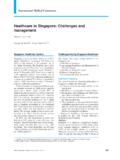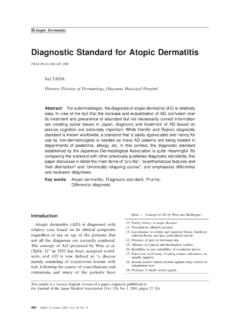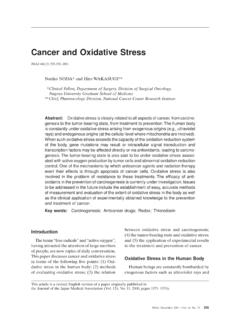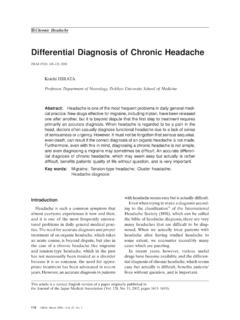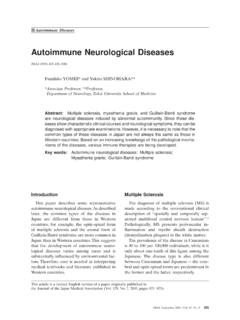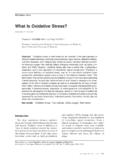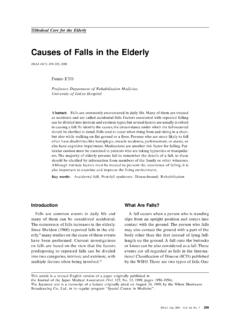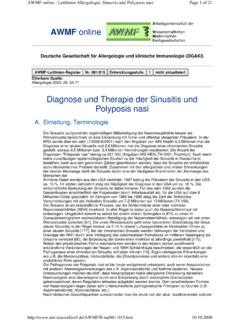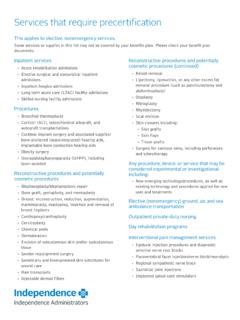Transcription of Carcinogenic Risk Factors - Med
1 JMAJ, June 2001 Vol. 44, No. 6245 Carcinogenic Risk FactorsJMAJ 44(6): 245 249, 2001 Hiroshi SAEKI* and Keizo SUGIMACHI**Assistant Professor and **Professor, Department of Surgery and Science,Graduate School of Medical Sciences, Kyushu UniversityAbstract: Carcinogenic risk Factors can be roughly divided into environmentalfactors and genetic Factors . Environmental Carcinogenic Factors include the follow-ing: ionized radiation, etc. as physical Factors ; benzo [ ] pyrene contained in tobaccosmoke, ethyl alcohol, etc. as chemical Factors ; and various viruses, etc. as biologicalfactors. Meanwhile, abnormalities in DNA repair genes and cell cycle genes havebeen identified as genetic Factors . Now that the mechanisms of carcinogenesis havebeen understood from a genetic standpoint, relationships between risk Factors andcarcinogenesis have also become comprehensible from the viewpoint of gene abnor-malities.
2 In the future, if susceptibility to cancer becomes predictable based onindividual genetic information, living environment, etc., then individualized cancerprevention will be realized from a new point of words:Environmental Factors ; Genetic Factors ; Cancer preventionIntroductionCancer is a disease caused by gene abnor-malities in any of the cells. However, clear indi-vidual difference exists in the susceptibility tocancer, which is related to Carcinogenic riskfactors. Cancer prevention should become pos-sible if risk Factors can be advances in recent cancer studies hasmade it possible to theorize on carcinogenicrisk Factors . Such risk Factors can be roughlydivided into environmental Factors and geneticfactors. It has long been known that the inci-dence of cancer differs according to the region,occupation, eating habits, and lifestyles.
3 Suchdifferences occur due to variations in carcino-gens in the environment which induce muta-tions in some genes. Genetic Factors , whichThis article is a revised English version of a paper originally published inthe Journal of the Japan Medical Association (Vol. 125, No. 3, 2001, pages 297 300).have been identified through studies on famil-ial neoplastic diseases, are considered to be thestate of susceptibility to cancer induced by thetransmission of mutations in the present report, we review the carcino-genic risk Factors that have been studied fromvarious FactorsIn the epidemiological studies conducted todate, various environmental Factors have beenshown to be Carcinogenic risk Factors . Amongthese, representative Factors are listed in Table1. These Factors include those whose carcino-genic effects can be avoided by altering life-styles such as a smoking habit, and can be said Feature: Prevention and Early Detection for Cancer246 JMAJ, June 2001 Vol.
4 44, No. 6to be directly linked with cancer prevention. Inaddition, many gene abnormalities induced bysuch environmental Factors have been discov-ered, and molecular targets of environmentalfactors are increasingly being Physical factors1) Ionized radiationIt is well known that ionized radiation maycause gene mutation or chromosome aberra-tion. The results of an epidemiological surveyof carcinogenesis in atomic bomb victims showincreased incidence of leukemia, lung cancer,etc. in the population. With respect to the tim-ing of carcinogenesis, while the incidence ofleukemia was high between 5 20 years afterthe exposure to atomic-bomb radiation, that oflung cancer is still high even now, more than 50years since the exposure. Applying the currenttheory that carcinogenesis is the result of themulti-stage Carcinogenic process acceleratedby the accumulation of mutations in cancer-related genes, to the above findings, it can beassumed that exposure to ionized radiationmay trigger off any of the steps involved inmultistage ) Ultraviolet lightUltraviolet light is an environmental factorthat is closely associated with skin cancer.
5 Al-though the incidence of skin cancer is extremelylow in Japan, it is frequently the most or secondmost prevalent cancer in Europe and irradiation may modify DNA basepairs, resulting in the formation of pyrimidinedimers. Moreover, ultraviolet light contributesto the production of a reactive oxygen species,which directs cells toward Chemical factors1) Benzo [ ] pyreneSmoking is most clearly associated with theincreased risk of cancer. Smoking-associatedcancers include lung cancer, head and neckcancer such as laryngeal and pharyngeal can-cers, esophageal cancer, bladder cancer, pan-creatic cancer as well as uterine cervix cancer is exhibiting a decreasing ten-dency in Europe and America. However, inJapan, lung cancer is the most common causeof cancer death in males, and its incidence isexpected to increase further in the future.
6 Thisis attributable to a slower decrease in the smok-ing rate as compared with Europe and Amer-ica. Concerning the Carcinogenic substancesin tobacco smoke, benzo [ ] pyrene is thoughtto have great significance. It is known thatbenzo [ ] pyrene may cause characteristicpoint mutation in the p53 gene, a tumor sup-H. SAEKI and K. SUGIMACHIT able 1 Known Environmental Carcinogenic FactorsFactorSite of carcinogenesis1. Physical factorsIonized radiationUltraviolet2. Chemical factorsBenzo [ ] pyrene: SmokingHeterocyclic amine: Overcooked meat and fishEthyl alcohol: DrinkingAflatoxin: Aspergillus flavusAsbestosCadmium3. Biological factorsHepatitis B virus, hepatitis C virusHTLV-1 (human T-lymphotrophic virus type 1)Human papilloma virusMyelopoietic tissue, Lung, Thyroid glandSkinLung, Head and neck, Esophagus, BladderMammary gland, Large intestineHead and neck, EsophagusLiverLung, PleuraProstateLiverT cell lymphomaUterine cervix, EsophagusJMAJ, June 2001 Vol.
7 44, No. 6247pressor gene,1) which is considered to be oneof the mechanisms of carcinogenesis due totobacco ) Ethyl alcoholHeavy drinking is also associated with theincidence of head and neck cancer as well asgastrointestinal cancer. With regard to esoph-ageal cancer in particular, alcohol intake hasbeen shown to trigger carcinogenesis coopera-tively with tobacco smoke. The results of ourstudies have also shown that heavy drinkingand smoking frequently leads to multiple can-cers in the head and neck and in the ) Furthermore, in patients with esophagealCARCINOGENIC RISK Factors cancer who consume a large amount of alcoholand tobacco, the incidence of p53 gene abnor-malities is 90% or higher,3) suggesting the pos-sibility that the p53 gene is the molecular targetfor the carcinogenesis of esophageal cancerdue to drinking and ) Heterocyclic amineHeterocyclic amine is known to be a carcino-genic substance in overcooked meat and experiments using rats, the substance hasbeen reported to induce both colon and pros-tate cancer in male animals, and breast cancerin female animals.
8 In epidemiological surveys,intake of overcooked meat and fish is also saidHereditary nonpolyposis coloncancer (HNPCC)Xeroderma pigmentosum (XP)Familial breast cancerRetinoblastomaLi-Fraumeni syndromeFamilial melanomaWilms tumorvon Hippel-Lindau diseaseFamilial adenomatouspolyposis (FAP)Familial gastric cancerNeurofibromatosis type IIJuvenile polyposisHereditary papillary renal cellcarcinomaMultiple endocrine neoplasiatype II (MEN2)Neurofibromatosis type 1 Table 2 Genetic Carcinogenic FactorsDiseaseRelated tumorsResponsible geneFunctionColon cancer, Cancer of uterinebodySkin cancerBreast cancerRetinoblastomaBreast cancer, Soft tissue tumor,Brain tumorMelanomaWilms tumorAngioblastoma, Renal cancer,Retinal angiomaColon cancerGastric cancerAcoustic neurinomaHamartomaPapillary renal cell carcinomaAdrenal pheochromocytomaMedullary carcinoma of thyroidNeurofibromaI.
9 DNA repair genes1)MLH1, MSH2 MSH6, PMS1 PMS22)XPA, XPBXPC, XPDXPF, XPG3)BRCA1, BRCA2II . Cell cycle genes1)Rb12)p533)p164)WT15)VHLIII. Genes responsible fortissue organization1)APC2)E-cadherin3)NF2IV. Signal transduction genes1)PTENSMAD42)MET3)RET4)NF1 DNA mismatch repairNucleotide excision repairRecombination repair (?)Transcriptional control,Cell cycle controlTranscriptional control,Cell cycle controlCell cycle controlTranscriptional controlTranscriptional controlMembrane structure andsignal transductionCell adhesionCell adhesionPhosphataseSignal transductionReceptor tyrosine kinaseReceptor tyrosine kinaseSignal transduction248 JMAJ, June 2001 Vol. 44, No. 6to be associated with the occurrence of breastcancer and colon ,5)3. Biological factorsBiological Carcinogenic Factors include vari-ous viruses. For example, chronic hepatitis andhepatic cirrhosis owing to persistent infectionwith hepatitis B virus or hepatitis C virus havebeen epidemiologically proven to be related tothe occurrence of liver cancer.
10 The hepatitis Bvirus is a DNA virus, and is known to incorpo-rate its partially deleted DNA into genomes inthe hepatocyte. On the other hand, the hepa-titis C virus is an RNA virus, whose genes donot encode reverse transcriptase. Therefore, itdoes not incorporate its DNA into the hosts genomes, and its contribution to carcinogenesisis FactorsCarcinogenesis is often sporadically observed,but sometimes concentrates in certain causes of such familial neoplastic diseaseswere unknown for many years, however, inrecent aggressive studies on cancer-related genes,the Rb1 gene which is responsible for retino-blastoma was identified in 1986, and subse-quently, a succession of genes responsible forhereditary neoplastic syndrome have been iden-tified. As shown in Table 2, these genes includeDNA repair genes, cell cycle genes, genes re-sponsible for tissue organization, signal trans-duction genes, etc.
